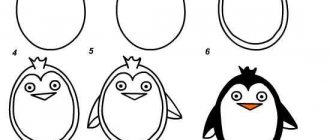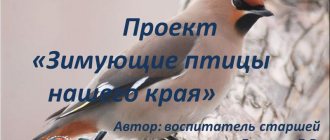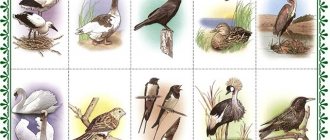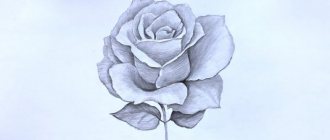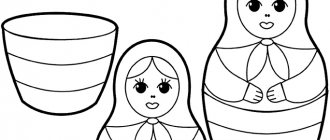On the topic: methodological developments, presentations and notes
Summary of an open lesson for the middle group using ICT.
An open lesson for non-speaking children of the younger group. Children are given the concept of the voices of domestic birds, children work with natural materials, and knowledge of folklore is formed.
Objectives: to arouse interest in drawing in co-creation with a teacher, to create conditions for experimenting with different materials, to continue mastering the printing method: to teach drawing in non-traditional ways.
Program contentTasksEducational:1. Teach to find and name domestic birds and their young familiar to children; 2. Clarify children's ideas about d.
Abstract of the educational activity “Bird Yard” in the senior group, combined type. Teacher - defectologist Ekaterina Yurievna Podolskaya.
Lesson summary for the circle work “Draw, little artist.”
To introduce children to small forms of folklore (riddles) in educational activities.
Source
Materials for drawing in the middle group
The materials that children will work with play a decisive role in preparing a drawing lesson.
What to draw on
As in the previous year, the optimal basis for the drawing is a sheet of A4 paper. For painting with paints, it is better to take watercolor sheets: they are denser, so even if the child heavily wets the brush, the image will not “float.” To depict an animal the size of the entire sheet, you can use thin cardboard.
Unlike the second younger group, even for small pencil pictures you should not use a smaller sheet format: firstly, children practice harmoniously arranging the composition on the base, and secondly, the kids’ muscles are already developed enough so as not to get tired when performing monotonous pencil movements for drawing large elements.
If the drawing involves individual work, then the sheet should not be larger than A4 format, otherwise it will be inconvenient for the child to work
How to draw
To make images of animals more expressive, children use gouache. In the middle group, the guys try to mix colors themselves (!) to obtain shades, for example, red and yellow, to get the orange of the required intensity to depict a squirrel or fox. The number of basic colors for drawing one composition expands to 6.
Gouache still remains the most favorite material for fine art.
Squirrel brushes Nos. 10–14 are used, including those with medium-length handles for making thin strokes to show the texture of the animal’s fur.
In the middle group, children switch to drawing with pencils of standard thickness. The number of colors increases to 12. At 4–5 years old, children combine pencils and wax crayons in their drawings.
What materials to supplement a drawing on the theme of animals?
Animalistic themes open up wide opportunities for including elements of other types of artistic activities into the composition. For example, when depicting cows in a meadow, children make an applique of grass: a strip of green paper is folded several times, cuts are made, unfolded and glued, leaving the “fringe” free - the composition acquires volume.
Applique motifs can be used to decorate designs: a paper bow for a cat, apples for a hedgehog, etc.
In addition to appliqué, plasticineography can be used in animal-themed drawings. For example, make a sun from plasticine twisted into a rope, and also add plasticine eyes and a nose to the image of the animal. Drawings in which parts made of plastic material alternate with drawn ones look original. For example, some of the hedgehog’s needles are drawn with pencils or wax crayons, and some are made with thin plasticine flagella.
Typically, to combine drawing and plasticine, templates with an image of an animal are used, which children paint and then complete with plasticine parts.
On the topic: methodological developments, presentations and notes
Educational field "Communication". Development of all components of oral speech. Integration of educational areas: “Cognition” (formation of vocabulary, sound culture of speech, coherent speech), “Health.
Summary of educational activities to familiarize yourself with the environment for young children on the topic “Poultry yard”.
communication lesson in 1st junior group.
Summary of direct educational activities on speech development in the first junior group on the topic “Poultry yard.”
Goal: To form children’s ideas about poultry and their chicks, to distinguish them by appearance and voices.
Goal: 1. Continue to consolidate the ability to sculpt the figure of poultry (rooster, chicken, from a whole piece of dough, transferring the shape of individual parts of the body to the shape of eggs). 2. Reinforce various techniques for sculpting everything.
Goal: 1. Continue to consolidate the ability to sculpt the figure of poultry (rooster, chicken, from a whole piece of dough, transferring the shape of individual parts of the body to the shape of eggs). 2. Reinforce various techniques for sculpting entire arms.
Source
How to draw a bird with a pencil: step by step for children
Drawing a bird is a task that often faces children and their parents. Sparrows, crows, jackdaws, nightingales, bullfinches, eagles, tits and other birds are common objects in children's albums. There is also room for unusual characters - firebirds and Angry Birds. However, everything is not as difficult as it sometimes seems for beginning artists. Using visual lessons and acting step by step, step by step, you can make a high-quality and clear drawing. After several trainings in drawing birds, the child will get better and better.
Step by step bird drawing lessons
Bird drawing lessons with step-by-step photos for beginners will help artists master the art of creating birds on paper.
Wintering bird: drawing a sparrow
Among wintering birds, the most popular are sparrows. Creating a drawing of such a bird is quite simple if you proceed in stages.
- You need to draw an elongated oval. This is the base of the bird's body.
- At the top of the workpiece you need to draw a figure with rounded contours. This will be the head. Several straight lines are drawn below. This is the tail of a wintering bird.
- Next, the beak is clearly drawn.
- Then you need to use smooth contours to create the outline of the breast, wings and make the eye.
- You need to draw the sparrow's legs with a pencil.
- All that remains is to color the drawing using colored pencils or felt-tip pens. If desired, you can use paints.
Bird in flight: drawing a seagull
- The process of drawing a bird in flight is much simpler than it seems. Even a child can cope with the task. First you need to draw a circle, which in the future will become the head, and the body of the bird. The bottom and top of the body should be a little sharp. There is no need for roundness here. Then the eye and beak are drawn, after which the contours of the circle must be erased with an eraser.
- Now we need to draw the span of the flying wings and the tail. The wing, which is located closer to the right edge of the paper sheet, should be much larger and longer than the second and the body. No need to grind!
- Next you need to finish drawing the paws and wings. The first ones need to be depicted folded tightly to each other.
- Then you need to draw lines that will make the thigh. To do this, the contour is drawn from the seagull's foot down. Next, the feathers on the tail and wings of the bird are depicted.
- It is necessary to remove all unnecessary contours.
- All that remains is to draw the shadows. The wings of the bird in flight should be made almost black and the underside of the seagull should be greatly darkened. Plus, a shadow also falls from the wing on the body. On the second wing, located closer to the left edge of the sheet, you should slightly outline the outlines of the feathers along the entire length. Similar contours need to be made on the body and around the head.
Summary of GCD on fine art in the preparatory group with the ZPR “Bird Yard”
art activity class in the preparatory group of a kindergarten for children with mental retardation
Viewing the contents of the document “Summary of GCD for Fine Arts in the preparatory group with ZPR “Bird Yard””
Municipal preschool educational institution
combined kindergarten No. 96
Summary of
direct educational activities
(Preparatory group for school with developmental disabilities)
GCD for drawing “Bird yard”
(preparatory group with mental retardation)
Target:
Consolidating knowledge on the topic “Poultry”
-Learn to create expressive images of poultry.
— To consolidate ideas about poultry.
— To consolidate the ability to identify and name the distinctive features of the appearance of poultry.
— Fix the ordinal count from 1 to 10.
— Cultivate an emotionally positive attitude towards the drawing process.
— Cultivate kindness, responsibility, a sense of love for nature.
Material:
Image of bird families (chicken, duck, goose)
Preliminary work:
Reading fiction and educational literature, looking at illustrations.
Educator:
Pinocchio came to visit us and brought images. Let's see who it is.
Skills Required for Drawing Animals in Intermediate Group
Before starting a drawing lesson, you need to take into account the skills that, according to the Federal State Educational Standard, are practiced by children 4–5 years old in this type of creativity:
- precision of brush strokes when painting, in particular, children learn to make thin strokes with the tip of a brush to draw the face, paws, tail - and intensive ones with the application of the entire pile to fill the color of the animal’s body;
Children of the middle group practice the skill of uniformly painting elements of a composition
- uniform hatching directions - from left to right, from bottom to top - with adjustment of the stroke span depending on the area of the surface being painted;
- varying the size of the strokes by changing the position of the pencil or brush, so if you tilt it closer to the paper, you will get wider lines, but placing the pencil almost vertically will help make small elements.
Drawing techniques in the middle group
At 4–5 years old, children practice both traditional and non-traditional drawing techniques.
Traditional painting techniques
As for classical techniques, in the middle group they are presented:
- drawing with a simple pencil - most often to indicate the contours of the image;
- drawing with colored pencils - children color the elements of the composition, trying to act exactly within the boundaries of the contours, while the direction of the strokes in the image of individual details does not change;
- drawing with wax crayons to obtain a rich color scheme of the picture;
- drawing with felt-tip pens - to practice coloring without going beyond the boundaries of the outline;
- drawing with gouache - not only for coloring pencil templates, but also for drawing the contours of animal images with paints;
- painting with watercolors - in particular, children practice multi-layered images, that is, they draw an element, let it dry, and then detail it with a different color (for example, they paint the body of a squirrel orange, and then draw the abdomen with yellow).
Photo gallery: examples of finished works in traditional techniques
In the drawing of a squirrel, children detail the face without first drawing contours
The drawing of the kids is done without a pencil outline; children show the boundaries of the image with lines made with a thin brush. In the middle group, drawings of animals in various poses are made from life
To depict the texture of a cat's fur, children sketch with small zigzag lines.
Felt-tip pens can be used to create drawings using non-traditional techniques, but they are rarely used in classical techniques, since they do not provide an opportunity for children to practice pressure force, as when working with pencils
Non-traditional drawing techniques in the middle group
In the middle group, drawings are practiced to depict wild and domestic animals using non-traditional techniques:
- with their palms, for example, when introducing the topic “Exotic Animals”, children draw a giraffe;
- poking with a semi-dry brush to depict animal fur;
- a fork for detailing needles or conveying the hard texture of an animal’s skin;
- an imprint with a crumpled piece of paper, for example, to show the volume of a bear cub’s fur.
Photo gallery: examples of drawings in non-traditional techniques
The texture of a hedgehog's spines can be shown by the imprint of a fork.
The stiffer and thinner the brush, the fluffier the kitten will be.
Children use a handprint to make the body, legs and tail of a giraffe, and paint the head with a brush.
The bear's face is detailed after the body is drawn with a poke of a brush.
In the middle group, the repetition of the drawing technique mastered last year by poking with a cotton swab is carried out by painting the goat template
Drawing "Poultry" for older children
Anna Shkurkina
Drawing "Poultry" for older children
Topic: Drawing : “
Poultry ” (
older age ) .
Goal: Continue to introduce children to migratory birds , consolidate knowledge about poultry .
Tasks: The ability to find and name the differences and similarities between migratory wild birds and domestic ones , to determine whose house it is by appearance. Encourage children to speak up. Develop the ability to find a cause-and-effect relationship.
Cultivate goodwill and a desire to help. To develop plasticity and ease of movement in children. Teach children to draw birds using the poking method . Develop a sense of composition, the ability to beautifully arrange a pattern on a board, decorating with a bird and flowers . To develop creative abilities, artistic taste and cultivate love and interest in folk arts and crafts. Teach children to draw poultry , building an image from its component parts (using geometric shapes)
.Develop imagination in
drawing unusual birds .
Demonstration material: Picture of a magpie, letter from Dunno, mnemonic table “Structure of birds ”
.
Handout: Voskobovich square, watercolor brushes, wax crayons and colored pencils. a simple pencil for sketching , an eraser, a glass of water.
1. Organizational moment: Surprise moment:
A magpie came to visit and in its beak brought a letter with a rebus.
2 Solving the puzzle and reading the letter.
3.Question: Do you know what other birds ?
4. Riddles for children about poultry .
5. Presentation “ Poultry ”
.
6. Consideration of the structure diagram of birds .
7.Questions: Do you think one bird is good or bad ?
How do domestic birds differ from migratory birds ?
Game: D/i “Exclude the unnecessary”
(
domestic and migratory birds ) .
D/i “Whose house?”
.
D/i "
Poultry " .
D/i “What do birds ?”
.
" Bird " (from Voskobovich's Square)
.
Support for children's initiatives:
What can you tell us about poultry ?
TRIZ: “Why poultry fly to warmer climes?”
.
Video physical education
.
Problem situation: From the letter we learned that Dunno does not know who poultry and does not understand them. He brought us pictures of birds , and these turned out to be birds painted with Gorodets painting. What should I do? What do we know about Gorodets painting? How are these toys different from poultry ? Can we help him?
Productive. Drawing :
1. Turkey (Dymkovo painting)
.
2. Poultry (Chickens, geese, ducks and peacocks)
.
3. "Miracle Bird "
.
Research work “House ants.
Friends or Enemies" for senior preschool age Today I want to share my research experience on the topic "House Ants. Friends or enemies? We recently participated in this project. Summary of the musical lesson “Poultry” for young children Goal: To develop children’s musical abilities in an accessible playful way To form preschoolers’ ideas about poultry Objectives. Summary of a lesson on speech development “Poultry” for children of primary preschool age Purpose: to introduce children to domestic birds; learn to name and distinguish birds; understand and answer the teacher’s questions. Progress of the lesson: Educator:. Source
How to motivate middle school students to work
For middle preschool age, drawing is a rather complex activity that requires concentration and attention - you need to tune in to it. Therefore, the teacher’s task is to choose the best option for motivating children, which would be suitable for the topic and would be accessible and interesting to children.
| Reception of motivation | The essence | Examples |
| Pictures, videos | They are used in life drawing classes - children see what the animal looks like and have the opportunity to look at it from different angles. | |
| Fairy tales | Children listen to a fairy tale or remember an already familiar plot, look at the pictures, and then draw their own illustrations based on them. |
|
| Cartoons | The creation of a drawing can be based on the plots of animated films. | To depict a polar bear, children review excerpts from the cartoon “Umka” |
| Surprise moment | A character comes to visit the group and presents a task. |
|
| Poems | Rhyming lines attract the children's attention and focus them on one type of activity. |
|
| Puzzles |
| |
| Music | Helps create the right atmosphere. | Paul Mauriat “In the World of Animals”, C. Saint-Saens “Carnival of the Animals”, etc. |
| Physical education minute | Used to change activities, carried out in the middle of a lesson, usually before drawing. |
|
One of the motivation techniques is the mandatory presence of pictures of animals.
